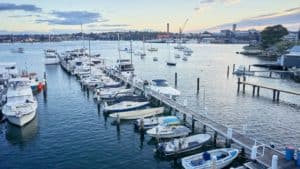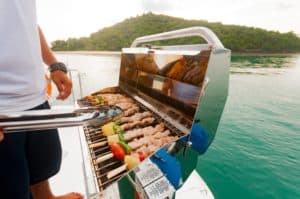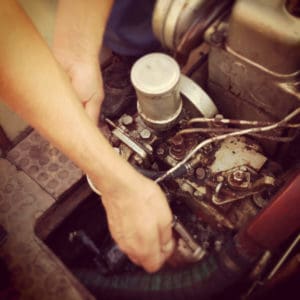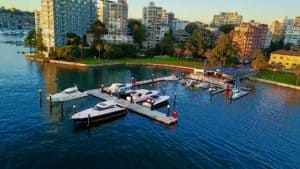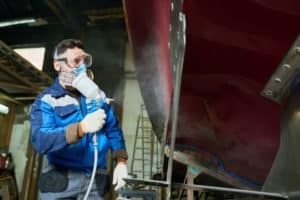In general, most boat hulls are constructed in a V-shape. These angled hulls allow the ship to drop below the surface and cut through water and waves at speed. The sharper the angle, the more a ship can slice through the water and keep the ride buttery smooth.
The general idea is that Deadrise is the measurement of the angle at which the boat’s V-shaped hull rises from the bottom point of the V, or keel.
An example of how this number might vary is: a flat hulled ship such as a pontoon boat would have a zero degree deadrise, whereas a speedboat designed to cut through water at high speeds could have a deadrise of upwards of 50 degrees.
It’s important to note, however, that most boats don’t have a deadrise that’s consistent throughout the entire hull of the ship. When you look at the most common ship designs, it is common to see ships with a higher deadrise at the front to flow through the water, and a flatter surface at the back.
Why does Deadrise matter?
Deadrise is an important metric that will allow you to judge how a boat will perform in different water conditions. What kind of water are you considering operating your craft in? Are you planning on doing any fishing off the aft with friends, or are you looking to cut your way through the water at high speeds while towing a wakeboarder? These are all decisions that can have an impact on what kind of deadrise your future watercraft will have.
The advantages of high Deadrise
High deadrise is great for someone that is looking to spend time out in open waterways, in that the increased angle at the front of the craft allows for easier passage through rough, choppy waters, with decreased turbulence. If speed is your desire, high deadrise is also going to be a key indicator you’re going to want to look for in a craft, as the higher angle of attack allows you to slip through the water with a lowered amount of choppy friction slowing you down.
This can aid your sporting endeavors as well, such as wakeboarding, parasailing, waterskiing, and other water-based pleasure sport, by allowing you to maintain a smooth speed to aid your passenger.
Where you might want to consider lower deadrise
Sometimes speed isn’t always what you’re looking for, and if that’s the case, you might want to consider something with little or no deadrise to accomplish your goals. When the deadrise is higher, the angle of the hull is higher, and thus the vessel sinks lower into the water, which can be less than ideal if you’re looking to fish in shallower waters, or going through marshes and wetlands.
For those that spend most of their time on protected waterways, flat-bottomed boats are your best option, and offer the absolute best stability to minimize rocking and rolling, they tend to draw very little water, and they don’t need much power to get onto plane.
How to measure Deadrise
When glancing at most modern boats, you might be tempted to think that they have a high degree of deadrise because they have a very deep V-shape at the bow. Deadrise can be measured at multiple points throughout the hull, as we’ve discussed previously, and the entry is not usually used as the determining factor.
Instead, Deadrise determined at the transom, or the back of the boat, is usually what you’ll see printed in the documentation of most boat manufacturers. The reasoning behind this line of thinking is that most modern boats cut through the water aft of the entry, and while a sharp bow is important for cutting through waves, most of the impact felt is going to be farther along the back of the vessel.
In some cases, you’ll see some manufacturers list in the brochure “variable-degree deadrise” which is a term for a boat that starts out with a sharp bow and tapers more and more as the line goes down the ship aft until reaching the transom. There are also a few boats out there which have different degrees of deadrise along the keel than they do just above it, and/or decreasing deadrise in a third section above that.
To find out the deadrise of a boat for yourself, you can check the manufacturer’s published specifications, either in the brochure or on their website. Alternatively, to get to the nitty gritty and do the work yourself, grab a protractor and a notebook and measure the Deadrise yourself, or if your phone has a measuring app with a level, you can also use that. Make sure to move down the boat to take multiple measurements to get an accurate idea.
Corleone Marinas – Sydney
Marinas can be a fantastic way for you to dive (metaphorically) into your new hobby. You have quick access to mechanics and knowledgeable staff who are there to help you.
Plus, marinas can offer you safe places to launch your boat without risk to your hull. Unloading just anywhere can cause hundreds if not thousands of dollars of damage to your nautical investment. Marinas offer you peace of mind that you’re getting in the water safely.
Thinking of using a marina for your newfound hobby? At Corleone Marinas, we offer four locations throughout Australia that can get you and your boat out on the water and enjoy the sunshine — no matter the time of year.
Contact us for more information about our services at our variety of locations today.


